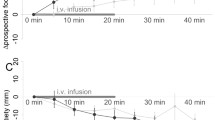Abstract
Previous studies have shown that when hungry rats are fed to satiety, the offset of eating is followed by a short period of activity superseded by resting behaviour. Observations of rats consuming wet mash or sucrose confirmed this “behavioural satiety sequence” and showed that the duration of resting was related to the intake of calories rather than of bulk. Fenfluramine reduced the consumption of sucrose and wet mash, but at anorectic and subanorectic doses, fenfluramine also suppressed resting behaviour; the effects of dl- and d-fenfluramine were qualitatively similar. It is argued that the suppression of resting behaviour by fenfluramine is incompatible with an enhancement of satiety.
Similar content being viewed by others
References
Antin J, Gibbs J, Holt J, Young RC, Smith GP (1975) Cholecystokinin elicits the complete behavioural sequence of satiety in rats. J Comp Physiol Psychol 89:784–790
Booth DA (1978) Prediction of feeding behaviour from energy flows in the rat. In: Booth DA (ed) Hunger models. Academic Press, London, pp 277–278
Booth DA, Gibson EL, Baker BJ (1986) Gastromotor mechanism of fenfluramine anorexia. Appetite [Suppl] 7:57–69
Blundell JE, Latham CJ (1980) Characterisation of adjustments to the structure of feeding behaviour following pharmacological treatment: effects of amphetamine and fenfluramine and the antagonism produced by pimozide and methergoline. Pharmacol Biochem Behav 12:717–722
Blundell JE, Latham CJ (1982) Behavioural pharmacology of feeding. In: Silverstone T (ed) Drugs and appetite. Academic Press, London, pp 41–80
Blundell JE, McArthur RA (1978) Behavioural flux and feeding: continuous monitoring of food intake and food selection, and the video recording of appetitive and satiety sequences for the analysis of drug action. In: Garattini S, Samanin R (eds) Anorectic agents: mechanisms of action and tolerance. Raven Press, New York, pp 19–43
Garattini S, Mennini T, Bendotti C, Invernizzi R, Gamanin R (1986) Neurochemical mechanism of action of drugs which modify feeding via the serotonergic system. Appetite [Suppl] 7:15–38
Kushner LR, Mook DG (1984) Behavioural correlations of oral and post-ingestive satiety in the rat. Physiol Behav 33:713–718
LeMagnen J (1971) Advances in studies on the physiological control and regulation of food intake. Prog Physiol Psychol 4:203–261
Pinder RM, Brogden RN, Gawyer PR, Speight TM, Avery GS (1975) Fenfluramine: a review of its pharmacological properties and its therapeutic efficacy in obesity. Drugs 10:241–323
Author information
Authors and Affiliations
Rights and permissions
About this article
Cite this article
Montgomery, A.M.J., Willner, P. Fenfluramine disrupts the behavioural satiety sequence in rats. Psychopharmacology 94, 397–401 (1988). https://doi.org/10.1007/BF00174696
Received:
Revised:
Issue Date:
DOI: https://doi.org/10.1007/BF00174696




